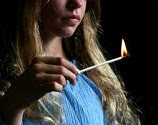
Home Fire Safety
While on a tour of the National Fire Academy in Emmitsburg, Maryland, I noticed several FEMA posters and flyers about National Arson Awareness Week communicating the importance of preventing youth fire setting. I didn't think much of it until I visited a National Historic Site nearby that almost lost one of their historic structures due to kids playing with fire.
So, to reinforce the great messages coming from our partners at FEMA and the U.S Fire Administration, I'm bringing the message to you.
Typically, children don't set fires in hopes of hurting someone or something. Most young kids are motivated to set fires out of curiosity or experimentation. According to the National Fire Protection Association (NFPA):
- Children playing with fire in the U.S. accounted for an average of 49,300 fires with associated losses of 110 civilian deaths, 880 civilian injuries, and $286 million in direct property damage per year between 2005 and 2009.
- Younger children are more likely to set fires in homes, while older children and teenagers are more likely to set fires outside.
- Lighters were the ignition source in half (50 percent) of child-playing fires in homes.
- A child's bedroom continues to account for 40 percent of child-playing home fires.
The U.S. Fire Administration's National Fire Incident Reporting System (NFIRS) data indicates that where age was cited as a factor in a fire's ignition by lighters or matches, 37 percent of these fires were started by juveniles aged 10 to 17.
Fire Info for You
Employees / Parents
Praise your child for practicing responsible behavior and showing respect for fire. Set a good example by using matches, lighters, and fire carefully. Children will imitate your positive behavior.
Park Leadership
Ensure that all residences have smoke alarms installed and that they are properly maintained.
Take Action
- Store matches, lighters, and other ignition devices out of children's reach and sight. A high, locked cabinet is best.
- Use child-resistant lighters. But remember, they're not child proof.
- Go to the FEMA website to learn more about juvenile fire setters.
NPS Fire Facts
The National Park Service has had historic structures lost and damaged due accidental fires started by children. There have been lives lost as well.
Unoccupied and seldom-used structures are particularly vulnerable. Raise your awareness of this issue and help prevent any further losses.
Last updated: October 28, 2016
